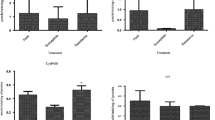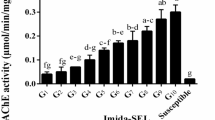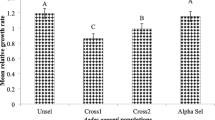Abstract
A temephos-induced resistance in Aedes aegypti that was developed for 24 generations exhibited 20.3-fold resistance as compared to susceptible strain. The diagnostic dose of temephos 0.02 mg/l exhibited gradual decrease in larval mortality with the progression of generations. An operational dose (1 mg/l) exhibited the LT50 value of 41.42 min in the susceptible population, whereas the value of the resistant population increased to 72.62, 108.86, 122.34, 182.03, 244.82 and 304.86 min in the fourth, eighth, 12th, 16th, 20th and 24th generation, respectively. The study carried out showed 120 min as the cut-off limit for differentiation between susceptible and resistant A. aegypti. Cross-resistance studies showed a varied degree of cross-resistance to fenthion, chlorpyrifos, malathion and DDT, whereas comparatively higher cross-resistance was observed to chlorpyrifos. Study on diagnostic doses of insecticides to A. aegypti females indicated a gradual decrease in adult mortality at every eighth generation as compared to susceptible population when exposed to malathion 0.8%, fenthion 0.25%, DDT 4%, permethrin 0.25% and temephos 6.5%, whereas little or no change in mortality when exposed to λ-cyhalothrin 0.03% and propoxur 0.1%, was observed. Thus, the expression of larval resistance was observed in adult stages also.



Similar content being viewed by others
References
Abbot WS (1925) method of computing the effectiveness of an insecticide. J Econ Ent 18:265–267
Ariaratnam V, Brown AWA (1969) Exposure time versus concentration in the WHO standard test for mosquito resistance to chlorohydrocarbon insecticides. Bull WHO 40:561–567
Braga IA, Lima JBP, SdeSA Soares, Valle D (2004) Aedes aegypti Resistance to temephos during 2001 in several Municipalities in the state of Rio de Janeiro. Sergipe and Alagoas, Brazil Mem Inst Oswaldo Cruz 99(2):199–203
Brogdon WG, McAllister JC (1998) Simplification of adult mosquito bioassays through use of time-mortality determinations in glass bottles. J Am Mosq Con Assoc 14(2):159–164
Carvalho Mdo S, Caldas ED, Degallier N, Vilarinhos Pde T, Souza LC, Yoshizawa MA, Knox MB, Oliveira C (2004) Susceptibility of Aedes aegypti larvae to the insecticide temephos in the Federal District Brazil. Rev de Saúde Pública 8(5):623–629
Center for Disease Control (2006) Evaluating mosquito for insecticide resistance; web based instruction. ww.cdc.gov/ncidod/wbt/resistance/assay/bottle/index.htm2006.
Chen CD, Nazni WA, Lee HL, Sofian-Azirun M (2005) Susceptibility of Aedes aegypti and Aedes albopictus to temephos in four study sites in Kuala Lumpur City Center and Selangor State, Malaysia. Trop Biomed 22(2):207–216
Finney DJ (1971) Probit analysis, 3rd edn. Cambridge University Press, Cambridge, pp 58–96
Georghiou GP, Wirth M, Tran H, Saume F, Knudsen AB (1987) Potential for Organophosphorous resistance in Aedes aegypti (Diptera: Culicidae) in the Caribbean area and neighbouring countries. J Med Entomol 24:290–294
Grant DF, Hammock BD (1992) Genetic and Molecular evidence for a transacting regulatory locus controlling glutathione S-transferase 2 expression in Aedes aegypti. Mol Gen Genet 234:169–176
Gubler DJ (1998) Resurgent vector-borne diseases as a global health problem. Emerg Infec Dis 4(3):442–450
Hamdan H, Sofian-Azirun M, Ahmad NW, Lim LH (200) Insecticide Resistance development in Culex quinquefasciatus (Say), Aedes aegypti (L.) and Aedes albopictus (Skuse) larvae against malathion, permethrin and temephos. Trop Biomed 22(1):45–52
Katyal R, Tewari P, Rahman S, Pajni HR, Kumar K, Gill KS (2001) Susceptibility Status of immature and adult stages of Aedes aegypti against conventional insecticides in Delhi, India. Dengue Bull 25:84–87
Lima JBP, Da-Cunha MP, Da Silva Junior RC, Galardo AKR, Soares SDS, Braga IA, Ramos RP, Valle D (2003) Resistance of Aedes aegypti to Organophosphates in several municipalities in the State of Rio De Janeiro and Espirito Santo, Brazil. Am J Trop Med Hyg 68(3):329–333
Luna JE, Martins MF, Anjos AF, Kuwabara EF, Navarro-Silva MA (2004) Susceptibility of Aedes aegypti to temephos and cypermethrin insecticides in Brazil. Revista de Saude Publica 38(6):842–843
Macoris MLG, Andrighetti MTM, Takaku L, Glasser CM, Garbeloto VC, Bracco JE (2003) Resistance of Aedes aegypti from the state of Sao Paulo, Brazil, to Organophosphates insecticides. Mem Inst Oswaldo Cruz, Rio de Janeiro 98(5):703–708
Mukhopadhyay AK, Patnaik SK, Satya Babu P (2006) Susceptibility status of some culicine mosquitoes to insecticides in Rajahmundry town of Andhra Pradesh, India. J Vect Borne Dis 43:39–41
National Vector Borne Disease Control Programme (NVBDCP) (2007) Guidelines for integrated vector management for control of dengue/dengue haemorrhagic fever 2007. Directorate General of Health Services, Ministry of Health and Family Welfare, Govt. of India. www.nvbdcp.gov.in.
Nazni WA, Lee HL, Sadiyah I (1998) Rate of resistance development in wild Culex quinquefasciatus (Say) selected by malathion & permethrin. Southeast Asian J Trop Med Pub Health 29:849–855
Ponlawat A, Scott JG, Laura Harrington C (2005) Insecticide susceptibility of Aedes aegypti and Aedes albopictus across Thailand. J Med Entomol 42(5):821–825
Rodriguez MM, Bisset JA, Ruiz M, Soca A (2002) Cross-Resistance to Pyrethroid and Organophosphate insecticides induced by selection with temephos in Aedes aegypti (Diptera: Culicidae) from Cuba. J Med Entomol 39(6):882–888
Saelim V, Brogdon WG, Rojanapremsuk J, Suvannadabba S, Pandii W, Jones JW, Sithiprasasna R (2005) Bottle and biochemical assays on temephos resistance in Aedes aegypti in Thailand. Southeast Asian J Trop Med Pub Health 36(2):417–425
Selvi S, Edah MA, Nazni WA, Lee HL, Azahari AH (2005) Resistance development and insecticide susceptibility in Culex quinquefasciatus against selection pressure of malathion and permethrin and its relationship to cross-resistance towards propoxur. Trop Biomed 22(2):103–113
Sharma SN, Saxena VK, Lal S (2004) Study on susceptibility status in aquatic and adult stages of Aedes aegypti and Aedes albopictus against insecticides at International Airport of south India. J Commun Dis 36(3):177–81
Tikar SN, Mendki MJ, Chandel K, Parashar BD, Prakash S (2008) Susceptibility of Immature Stages of Aedes (Stegomyia) aegypti; vector of dengue and chikungunya to insecticides from India. Parasitol Res 102(5):907–913
Wirth MC, Georghiou GP (1999) Selection and characterization of temephos resistance in a population of Aedes aegypti from Tortola, British Virgin islands. J Am Mosq Con Assoc 15(3):315–320
World Health Organization (1981) Criteria and meaning of tests for determining the susceptibility or resistance of insects to insecticides, WHO/VBC 81.6.
World Health Organization (1986) Diagnostic dose for the detection of resistance in “Resistance to vectors and reservoir of diseases to pesticides WHO tech”. Report Series. VBC 81.6: 86-87.
Yergolkar PN, Tandale BV, Arankalle VA, Sathe PS, Sudeep AB, Gandhe SS (2006) Chikungunya outbreak caused by African genotype, India. Emerg Infect Dis 12:1580–1583
Acknowledgement
The authors are thankful to Dr. R. Vijayaraghavan, Director, Defence Research and Development Establishment (D.R.D.E), Gwalior, for encouraging our efforts in carrying out this research work.
Author information
Authors and Affiliations
Corresponding author
Rights and permissions
About this article
Cite this article
Tikar, S.N., Kumar, A., Prasad, G.B.K.S. et al. Temephos-induced resistance in Aedes aegypti and its cross-resistance studies to certain insecticides from India. Parasitol Res 105, 57–63 (2009). https://doi.org/10.1007/s00436-009-1362-8
Received:
Accepted:
Published:
Issue Date:
DOI: https://doi.org/10.1007/s00436-009-1362-8




